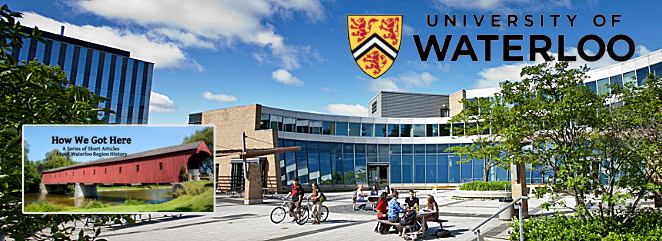The University of Waterloo, often called Waterloo (UW or UofW for short), is a public research university in Ontario, Canada. Its main campus sits on a vast stretch of land (almost 1,000 acres!) next to Waterloo Park and the uptown Waterloo area. Established in the late 1950s, the university has grown to encompass not only this main campus but also several smaller satellite campuses and affiliated colleges. With a strong focus on research, Waterloo is a member of a prestigious group of Canadian universities called the U15.
University of Waterloo’s Birth
The University of Waterloo’s story starts not with grand buildings or opening ceremonies, but in a boardroom on a Friday afternoon. On December 16th, 1955, 17 local leaders gathered at Waterloo College, a small college near what is now University Avenue and Albert Street. Gerry Hagey, the president of Waterloo College, had a vision – to expand the college’s reach and transform it into something bigger.
Hagey, a former business executive himself, had already convinced some friends of the potential. This historic meeting brought together other influential figures – business leaders and professionals – to discuss this ambitious plan. The three-page typed minutes of the meeting reveal there were plenty of questions and discussions.
But the energy for change was strong. A crucial motion was proposed by Carl Pollock, president of a local company, and seconded by another industry leader. The motion? To establish a Board of Governors for a brand new Faculty of Science, affiliated with Waterloo College. Those present, convinced of this bold idea, signed their names in agreement. Even those who couldn’t attend the meeting were given the chance to join this exciting venture.
Leading this historic meeting was Ira Needles, president of a major Canadian company, with Carl Dare from the Dare Biscuit Company taking notes as secretary. Other attendees included prominent figures from local businesses, a newspaper editor, a doctor, and a lawyer. Interestingly, even a banker was on the guest list, though unable to attend that day.
First Steps – Waterloo College Associate Faculties
Before wrapping up, the group formed a committee to tackle the legal aspects and collaborate with the existing Waterloo College board. There was an acknowledgment that cooperation from the governing church body, the Canada Synod of the United Lutheran Church, would also be crucial.
This initial meeting sparked a series of discussions. By the time the university welcomed its first students in 1957, the vision had grown. Engineering joined science as a core offering, and the institution was named Waterloo College Associate Faculties. In 1959, it became a fully independent university – the University of Waterloo – and partnered with the existing St. Jerome’s College. Meanwhile, the original Waterloo College continued its journey, eventually transforming into today’s Wilfrid Laurier University.
This seemingly ordinary boardroom meeting in 1955 marked the birth of a different kind of university. The University of Waterloo, with its focus on research and innovation, can trace its roots back to this gathering of enthusiastic minds with a shared vision for the future.
December 1958 – The university’s first building, dedicated to Chemistry and Chemical Engineering, is completed, laying the groundwork for future scientific exploration.
1962 – The concept of cooperative education expands beyond engineering with the establishment of the first co-op program in the Department of Physics. This paves the way for co-op programs across various disciplines.
1975 – Economics students become the first in the Arts faculty to participate in a co-op program, solidifying the value of co-op education in diverse fields of study.
2000 – En-hui Yang, a graduate of the electrical and computer engineering program, develops a groundbreaking compression algorithm. This technology, used by millions, allows for data compression without sacrificing quality.
2003 – The William M. Tatham Centre for Cooperative Education and Career Services opens its doors. This building, the largest dedicated co-op facility in a Canadian university, highlights the university’s commitment to this unique learning approach.
2006 Canada’s only co-op program for pharmacists launches at the School of Pharmacy and Health Sciences Campus in Kitchener.
2013 (Economic Impact Report) – The University of Waterloo’s economic impact on Ontario is estimated to be a staggering $2.6 billion annually, showcasing its significant contribution to the province’s economy.
A Legacy of Innovation: Waterloo’s Journey Continues
From a single meeting in 1955 to a thriving hub of research and learning, the University of Waterloo’s story is one of remarkable transformation. Today, Waterloo boasts a vibrant student body of over 40,000 in both undergraduate and postgraduate level and over 200,000 alumni in 152 countries. From its humble beginnings to its current standing as a leader in research and education, Waterloo’s story is a proof of the power of vision, collaboration, and a relentless pursuit of innovation.

About The Author – Ibrahim Mustapha
Ibrahim crafts high-performance content that connects brands with their audiences and drives impactful results. He has extensive writing experience across various niches, including SaaS, Technology, Health, Nature, and Lifestyle. His track record of earning five-star ratings from clients serves as a proof of his unwavering commitment to excellence.

